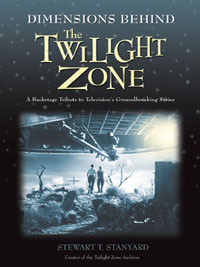Magic Realism Comes To The Suburbs
By Neil Peart
Dimensions Behind The Twilight Zone by Stewart T. Stanyard, April 1, 2007, transcribed by pwrwindows@yahoo.com
For a kid growing up in the Canadian suburbs in the late '50's and early '60's, television was limited in quantity, variety, and scope. (And color, as our family didn't get a color set until I was in my teens.) Our rooftop antenna brought in five channels - three American and two Canadian - and some of the shows were unique to the times, like westerns and the kind of variety shows hosted by Ed Sullivan, Jackie Gleason, or Red Skelton. Other shows were the familiar sitcoms with Andy Gritffith or Lucille Ball that still play on cable channels (and are still remade every season with different names), and the eternally popular, ever-changing (yet never-changing) crime dramas and doctor shows.
At first, the big television event of the week for me was Saturday morning cartoons, but a little later, I discovered The Twilight Zone. Not only was it different from everything I had seen before in mood, style, and depth, it introduced the possibility of magic into everyday life - just as Rod Serling and the show's other writers often did in their stories.
In retrospect, Rod Serling may have pioneered what is now called "magic realism" even before the Latin-American novelists. His screenplays were always rich in carefully drawn details of background and character, whether the story was set in teh familiar world of the suburbs, a typical contemporary background like the Old West, or an imaginary planey. But in the end, there was always a supernatural twist, sometimes ironic, sometimes thought-provoking, sometimes chilling. It was those deeper qualities that elevated the story, and the series, above any of the other "sci-fi" shows of the time, or since.
For me, The Twilight Zone stood out on the telescape like color against black-and-white (though the opposite was true, of course), and it was an introduction to the wonderful notion that entertainment could embrace imagination, irony, morality, and intelligence, in addition to suspense, atmosphere, action, and drama.
In my early years with Rush, in the mid '70s, when we first played in the Los Angeles or New York areas, we were thrilled to find television channels that still showed reruns of The Twilight Zone. Our youthful fascination with the show was rekindled, and we were inspired to dedicate one of our early albums (Caress of Steel, 1975) to Rod Serling, and we wrote a song for our 2112 album, in 1976, titled after the show and in tribute to it. The song included references to two episodes in particular, "Will The Real Martian Please Stand Up," and "Stopover In A Quiet Town."
Almost 30 years later, and 40 years after the series was aired, it is wonderful to know that The Twilight Zone continues to be celebrated and enjoyed, as this book proves, and I am very happy to see the legacy of Rod Serling and his collaboratoes live on.
Neil Peart is the author of Masked Rider, Ghost Rider, and Traveling Music: The Soundtrack To My Life And Times, and is the drummer and lyricist for the legendary rock band, Rush.
